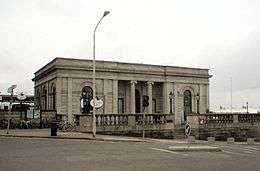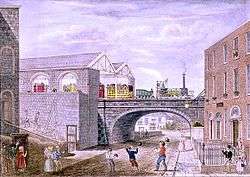Dublin and Kingstown Railway
|
The line in 1837 | |
| Dates of operation | 1831–1854 |
|---|---|
| Successor | Dublin, Wicklow and Wexford Railway |
| Track gauge |
1,600 mm (5 ft 3 in) Originally 1,435 mm (4 ft 8 1⁄2 in) |
| Length | 8.41 miles (13.53 km) |
The Dublin and Kingstown Railway (D&KR), which opened in 1834, was Ireland’s first railway. It linked Westland Row in Dublin with Kingstown Harbour in County Dublin.
History
The Dublin and Kingstown Railway Company was founded in 1831 by businessmen in the city to look into building a railway. Within two years, they had a contractor and a parliamentary act.[1] The construction contract was awarded to William Dargan.[2]


Building of the 10 km (6 mi) line was delayed by opposition from two different landowners who insisted on large cash compensations and in the case of Lord Cloncurry the building of a private foot bridge over the line to a bathing area complete with a Romanesque temple, a short tunnel and a cutting to maintain his privacy. Part of the line ran on an embankment built across the strand between Merrion and Blackrock which later led to the formation of Booterstown marsh. The first train ran on 9 October 1834, consisting of eight carriages hauled by the locomotive Hibernia.
From Bradshaw's 1843 timetable:[3]
DUBLIN AND KINGSTOWN
The mail bags are conveyed by the 8½ a.m. by Holyhead; 5 and 10 p.m. by Liverpool.
From both ends on week days, every half-hour from 6 a.m. until 11½ p.m., stopping at all stations, Viz: Booterstown, Black Rock and Salt Hill.
An extra train from Kingstown at 9¼ a.m. stopping at Merrion in addition to the usual stations.
An extra train every day, at 4¾ p.m., stopping at Merrion only. This train will convey passengers to Her Majesty's mail packet, starting from Kingstown at 5¼ p.m.
The 11 p.m. Up and Down, also stop at Merrion every day.
Sunday trains same hours as on weekdays, with extra trains every ¼ of an hour from 11¾ a.m. to 5¾ p.m. and from 7¾ to 10¼ p.m.
FARES — First Class 1s, second class 8d, third class 6d.
The line was extended to Dún Laoghaire station’s current location using the then existing Dalkey Quarry industrial tramway cutting which ran to the West Pier. However, this took a further three years, again due to opposition from local property owners, this time led by Thomas Gresham. The station building was converted in 1971 to a restaurant, Brasserie Na Mara.
The D&KR later included the Dalkey Atmospheric Railway branch.
In 1854 the lines were leased to the Dublin, Wicklow and Wexford Railway who changed the original standard gauge to the wider Irish gauge.
The line is now part of the DART route.
Gauge
The D&KR was originally 4 ft 8 1⁄2 in (1,435 mm) but because there came to be two other broader gauges, it was decided to regauge everything to a new gauge of 5 ft 3 in (1,600 mm). This was done in 1857 at a cost of £38,000.
Rolling stock
- 1835 - 2 locomotives from George Forrester and Company
Two items of Dublin and Kingston stock have survived into preservation. Open-sided second No. 38, built in 1834 of 4' 8.5" gauge and re-gauged to 5' 3" in 1857, was stored by the DWWR, along with third No. 48, built in 1838. They went to the 100th anniversary of the British Rainhill Trials in 1929 with GSWR locomoitve No. 36 before being returned to rot in Inchicore dump. No. 48 was restored and preserved by the Belfast Transport Museum in 1964, where it remains in the Ulster Folk and Transport Museum to this day. Unfortunately, No. 38 was considered to be too badly damaged by weathering and rot to be overhauled, and was scrapped while No. 48 was restored.
Gallery
-

The view from Blackrock towards Merrion, 1834
-

From the Martello Tower at Seapoint, looking towards Kingstown, 1834
-

"From the Foot Bridge at Sea Point Hotel, looking towards Salt Hill....Kingstown Harbour in the distance", 1834
-

The original Kingstown railway station (1844 - 1971), now a restaurant. Architect: John Mulvany
-

Rear of Westland Row Station, Cumberland St., first train, 1834
See also
References
- ↑ Cox, Ronald C.; Gould, Michael H. (1998). Civil Engineering Heritage: Ireland. London: Thomas Telford. p. 30. ISBN 978-0-7277-2627-8.(1 & 2 Wm. IV, Cap. 69)
- ↑ Knowles, Richard Brinsley (April 1854). "Memoir of William Dargan". The Illustrated London magazine (London: Piper, Stephenson, and Spence) 2: 166. Retrieved 10 February 2011.
- ↑ March 1843 timetable from Bradshaw's Railway Monthly (XVI)
- Murray, K. A. (1981). Ireland's First Railway. Dublin: Irish Railway Record Society. ISBN 0-904078-07-8.
External links
| Wikimedia Commons has media related to Dublin and Kingstown Railway. |
